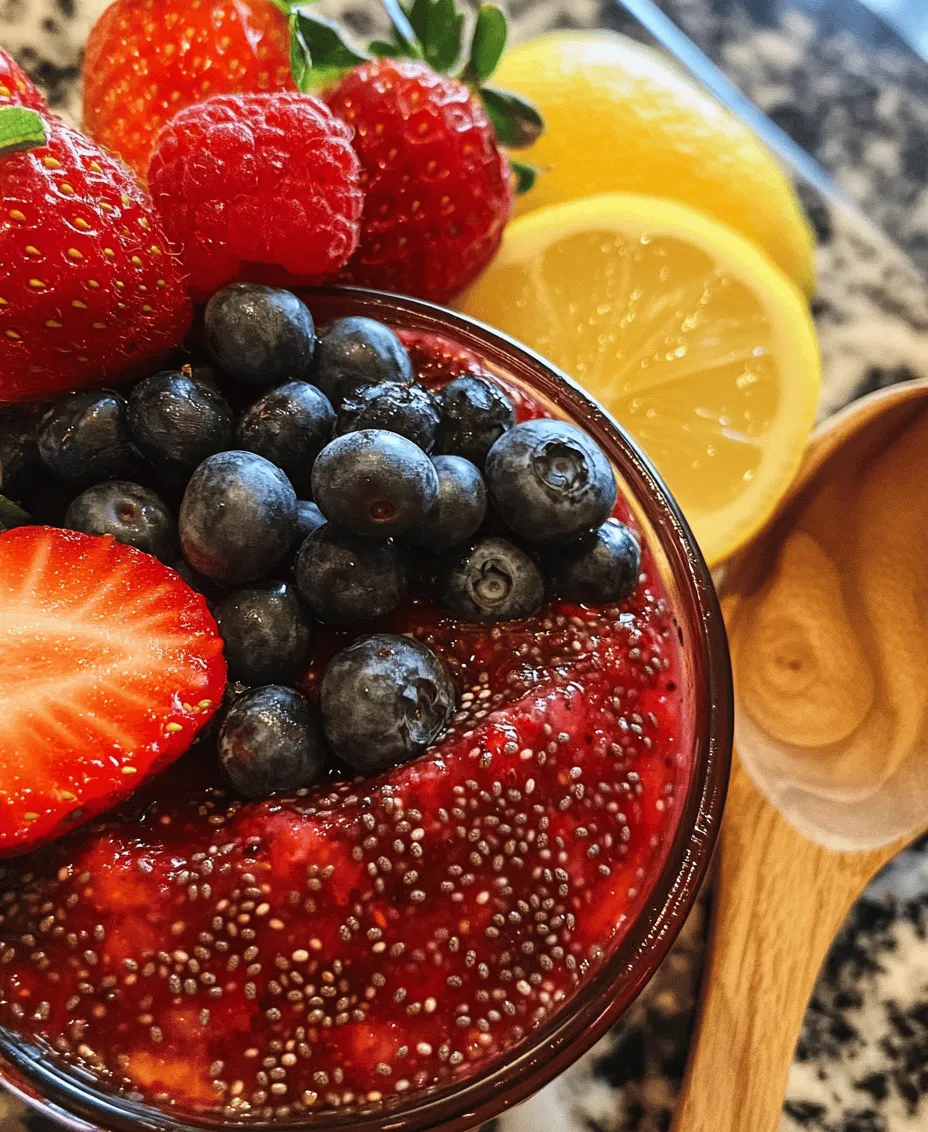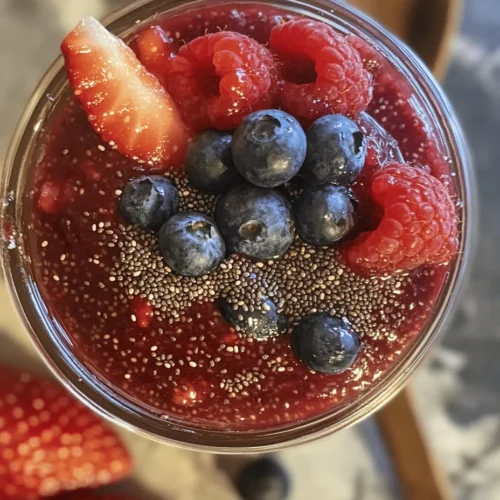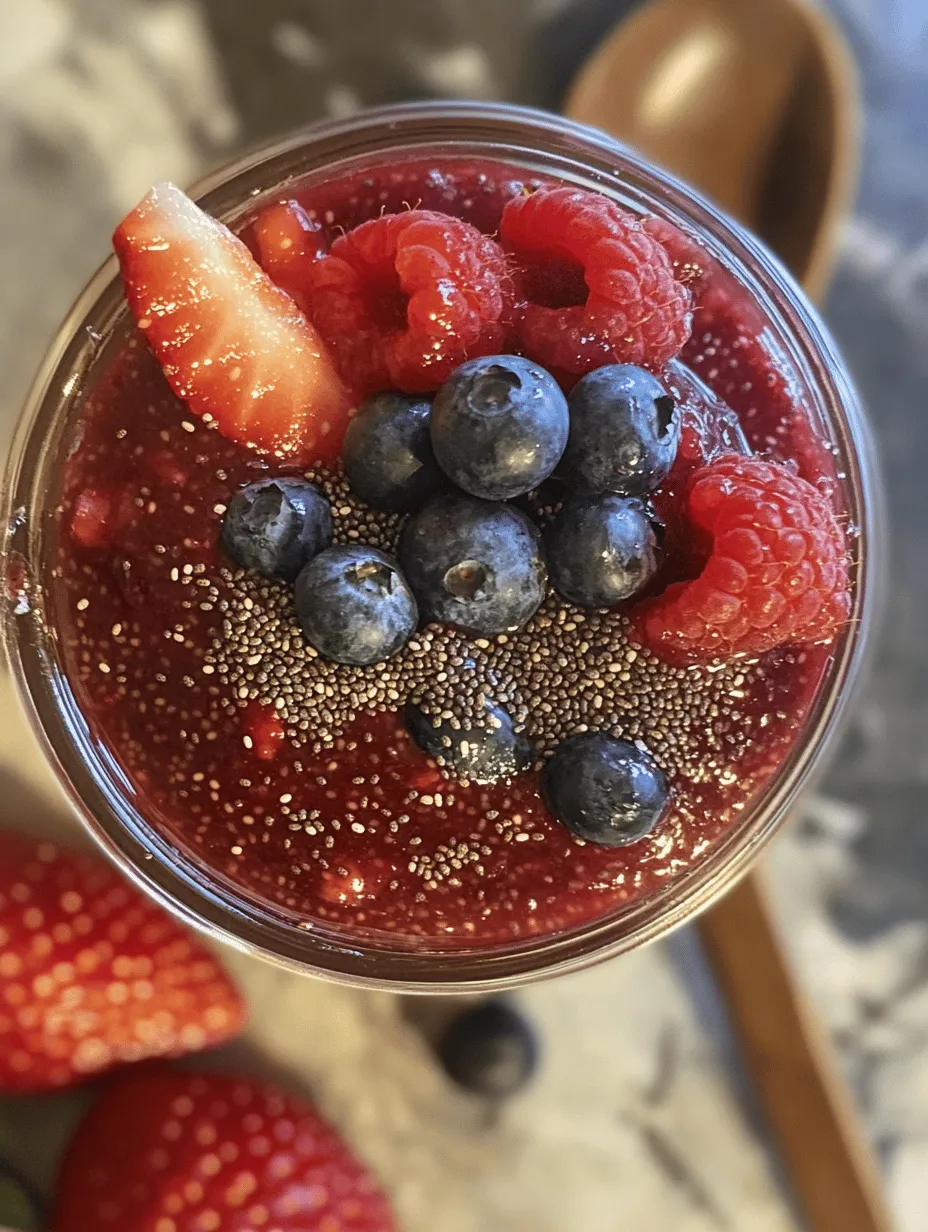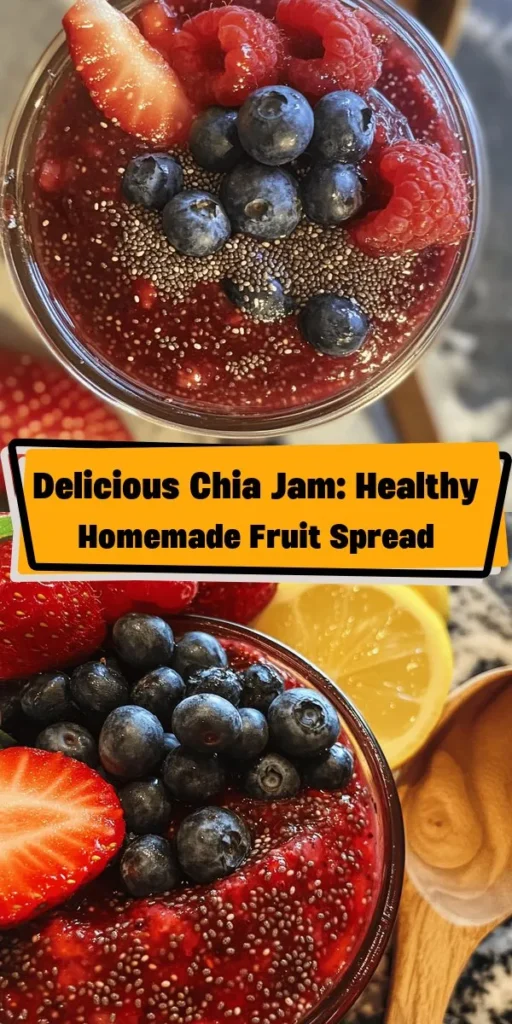Introduction
In recent years, the trend of healthy eating has surged, prompting many home cooks to seek out natural ingredients that not only enhance flavor but also contribute to overall well-being. One such delightful creation that has gained popularity is homemade jam, particularly a unique version made with chia seeds. This Chia Delight recipe is a testament to the versatility and health benefits of using wholesome ingredients, offering a delicious alternative to store-bought jams that are often laden with added sugars and preservatives.
Chia seeds, small yet mighty, play a pivotal role in this recipe. Not only do they serve as a natural thickening agent, but they are also packed with nutrients that support a healthy lifestyle. The beauty of this jam lies in its adaptability; you can customize it to your liking by choosing your favorite fruits and adjusting sweetness levels according to your preferences. Whether you want a vibrant strawberry jam to spread on your morning toast or a summery peach jam to complement your yogurt, the possibilities are endless.
In this article, we will delve into the nutritional benefits of chia seeds, explore the best fruits to use for making your jam, compare popular sweeteners, and provide you with a step-by-step guide to creating your very own Chia Delight jam.
Understanding Chia Seeds and Their Benefits
Chia seeds originate from the Salvia hispanica plant, which is native to Central America. These tiny seeds have been used for centuries by ancient civilizations, including the Aztecs and Mayans, not only for their nutritional value but also as a source of energy during long journeys. Today, chia seeds have gained recognition as a superfood, thanks to their impressive nutritional profile.
One of the standout features of chia seeds is their high fiber content. Just one ounce of chia seeds contains approximately 11 grams of fiber, which can contribute to feelings of fullness and aid in digestion. Additionally, chia seeds are an excellent source of protein, containing about 4 grams per ounce, making them a great option for those looking to enhance their plant-based protein intake.
Another remarkable benefit of chia seeds is their abundance of omega-3 fatty acids, which are essential for heart health and have been linked to reduced inflammation in the body. They also contain various antioxidants that help combat oxidative stress, further promoting overall health.
When it comes to using chia seeds in recipes, their ability to absorb liquid and swell into a gel-like consistency makes them an ideal thickening agent. This natural thickening property is particularly beneficial in making jams, as it eliminates the need for traditional pectin or excessive sugars. Beyond jam, chia seeds can be incorporated into smoothies, puddings, oatmeal, and even baked goods, showcasing their versatility in the kitchen.
Choosing the Right Fruits for Your Jam
Selecting the right fruits is crucial for creating a delicious and flavorful chia jam. The beauty of this recipe is that you can use a variety of fruits, each offering its unique taste and texture. Here are some of the best fruits to consider for your Chia Delight jam:
Strawberries
Strawberries are a classic choice for jam-making. Their natural sweetness and juicy texture create a delightful base for chia jam. When selecting strawberries, look for bright red, firm berries with a sweet aroma. They are typically in season from late spring to early summer, so it’s the perfect time to whip up a batch of strawberry chia jam when they are at their peak.
Blueberries
Blueberries are another fantastic option, known for their vibrant color and antioxidant properties. They have a slightly tangy flavor that balances well with the sweetness of other fruits or sweeteners. When choosing blueberries, opt for plump, firm berries with a deep blue color. They are generally in season from mid-summer to early fall, making them an excellent choice for jam during those months.
Raspberries
Raspberries are wonderfully fragrant and add a burst of tartness to your chia jam. Their delicate structure can break down easily during cooking, creating a smooth and rich texture. Look for raspberries that are firm and brightly colored, as these are signs of ripeness. They are typically in season from late spring to early summer, so make sure to take advantage of their availability.
Peaches
Peaches bring a sweet and juicy flavor to chia jam, making them a delightful addition, especially in the summer months. Their natural sweetness means you may need less added sweetener, allowing the fruit’s flavor to shine through. When selecting peaches, choose those that yield slightly to pressure and have a fragrant scent. They are usually in season from late summer to early fall.
Seasonal Availability and Flavor Profiles
When selecting fruits for your jam, consider their seasonal availability to ensure that you are using the freshest and most flavorful options. Seasonal fruits not only taste better but also tend to be more affordable. The flavor profiles of the fruits you choose can also influence the overall taste of your jam. For example, mixing sweeter fruits like strawberries with tangy fruits like raspberries can create a well-balanced jam that pleases the palate.
Sweeteners: Honey vs. Maple Syrup
When it comes to sweetening your Chia Delight jam, you can choose from a variety of options, with honey and maple syrup being two popular choices. Each sweetener brings its unique flavor and health benefits to the table, allowing you to adjust sweetness levels based on personal preference and the natural sugar content of the fruits you use.
Honey
Honey is a natural sweetener that has been used for centuries due to its medicinal properties. It is rich in antioxidants and has a lower glycemic index than refined sugar, which means it can provide a more stable source of energy without causing rapid blood sugar spikes. Additionally, honey adds a subtle floral flavor that can enhance the overall taste of your jam. When using honey, consider its flavor profile—lighter varieties, like clover honey, have a milder taste, while darker honeys, like buckwheat honey, offer a more robust flavor.
Maple Syrup
Maple syrup is another fantastic option for sweetening your jam. It is rich in minerals such as manganese and zinc, and like honey, it has a lower glycemic index compared to refined sugars. Maple syrup has a warm, caramel-like flavor that pairs beautifully with fruits, particularly stone fruits like peaches and plums. When selecting maple syrup, look for pure maple syrup labeled as Grade A or Grade B; the latter has a stronger flavor and dark color, making it an excellent choice for hearty jams.
Adjusting Sweetness
When making chia jam, it’s essential to taste as you go. The natural sweetness of your chosen fruits will vary, so adjusting the amount of sweetener is key to achieving the perfect balance. Start with a small amount of honey or maple syrup and gradually increase it until you reach your desired level of sweetness. You can also experiment with combining sweeteners to create a unique flavor profile that complements your jam.
Step-by-Step Instructions for Making Chia Delight Jam
Now that you have a solid understanding of the ingredients and concepts behind Chia Delight jam, let’s dive into the step-by-step process of making this delicious and healthy spread. Follow these detailed instructions to create your own batch of homemade chia jam.
Step 1: Preparing the Fruit
Begin by washing your chosen fruits thoroughly under cool running water. If you’re using strawberries, remove the green tops and slice them into smaller pieces for easier cooking. For blueberries and raspberries, simply toss them into a bowl. If you’re using peaches, peel the skin and chop them into bite-sized pieces. The key is to ensure that your fruit is ripe, fresh, and ready to release its natural juices during the cooking process.
Step 2: Cooking and Mashing the Fruit
In a medium saucepan, combine your prepared fruit along with a dash of water to help with the cooking process. Heat the mixture over medium heat, stirring occasionally to prevent sticking. Allow the fruit to cook for about 5-10 minutes, until it begins to soften and break down. For a smoother jam, you can use a potato masher or fork to mash the fruit to your desired consistency. If you prefer a chunkier texture, simply stir the fruit without mashing it too much.
Step 3: Adding Chia Seeds and Flavorings
Once your fruit has reached the desired consistency, remove the saucepan from the heat. Stir in the chia seeds, which will absorb the liquid and help thicken the jam as it cools. The typical ratio is about 1 tablespoon of chia seeds for every cup of fruit, but you can adjust this based on how thick you want your jam to be. If you’d like to enhance the flavor, this is also the time to add your chosen sweetener—start with a small amount, and adjust to taste. For an extra layer of flavor, consider adding a splash of vanilla extract or a squeeze of lemon juice.
By following these initial steps, you are well on your way to creating a delightful and nutritious chia jam that can be enjoyed in numerous ways. Stay tuned for the continuation of this recipe, where we will delve deeper into the final steps of the jam-making process, including how to store your creation and additional tips for perfecting your Chia Delight.

Cooling and Storing the Jam
Once your Chia Delight jam has reached the desired thickness, it’s essential to allow it to cool properly before transferring it to storage containers. Cooling helps to set the texture and flavors while ensuring that the jam maintains its freshness. Here’s how to do it:
1. Cool Down: Remove the pot from heat and let the jam cool at room temperature for about 15 to 20 minutes. You’ll notice it thickening further as it cools.
2. Transfer to Containers: Once cooled, transfer the chia jam into clean, airtight jars or containers. Glass jars work best as they are non-reactive and help to preserve the flavor.
3. Seal and Refrigerate: Seal the jars tightly and store them in the refrigerator. Homemade chia jam will typically stay fresh for about 1 to 2 weeks. For longer storage, consider freezing portions in ice cube trays or freezer-safe bags.
Alternative Flavoring Options
One of the best aspects of making your own chia jam is the opportunity to customize flavors. While the basic recipe is delightful, experimenting with additional ingredients can elevate your jam to new heights. Here are some flavoring options to consider:
– Cinnamon: A sprinkle of ground cinnamon can add warmth and depth to your jam. It pairs particularly well with apple or pear-based chia jams.
– Vanilla Extract: A teaspoon of pure vanilla extract brings a rich, aromatic flavor that enhances the sweetness of your fruits, making it an excellent addition to berry jams.
– Nutmeg and Ginger: For a spiced twist, consider adding a pinch of nutmeg or a small amount of grated ginger. These spices not only add flavor but also pack a nutritional punch, offering anti-inflammatory benefits.
– Citrus Zest: Adding a touch of lemon or orange zest can brighten the flavors and provide a refreshing balance, especially in heavier jams like fig or peach.
– Coconut: Stirring in unsweetened shredded coconut can give your jam a tropical flair, making it perfect for summer spreads.
Feel free to mix and match these flavors to find your perfect combination. The beauty of homemade chia jam lies in its versatility and ability to cater to your taste preferences while also boosting its nutritional profile.
Storage and Shelf Life of Chia Jam
Proper storage is vital to maintaining the freshness and flavor of your chia jam. Here are some best practices:
– Refrigeration: Store your chia jam in an airtight glass jar in the refrigerator. This will help prevent any unwanted odors from contaminating your jam while keeping it fresh.
– Shelf Life: Generally, homemade chia jam can last in the refrigerator for about 1 to 2 weeks. If you find that you cannot consume it within this timeframe, consider freezing it.
– Freezing: For longer storage, chia jam freezes beautifully. Portion it into ice cube trays or small freezer-safe containers. This way, you can thaw only what you need at any given time.
– Signs of Spoilage: Always check for signs of spoilage before consuming. If you notice any off smells, unusual textures, or mold, it’s best to discard the jam. Fresh chia jam will have a vibrant color and a sweet, fruity aroma.
By adhering to these storage tips, you can ensure that your Chia Delight remains a delicious and healthy option for days to come.
Serving Suggestions for Chia Jam
The versatility of chia jam makes it an exciting addition to various dishes beyond your standard toast. Here are some creative serving suggestions to inspire your culinary adventures:
– Yogurt Parfait: Layer your chia jam with yogurt and granola for a delicious breakfast or snack. The combination of creamy yogurt, sweet jam, and crunchy granola creates a balanced and satisfying treat.
– Oatmeal: Stir a spoonful of chia jam into your morning oatmeal. It will naturally sweeten your oats while adding a fruity flavor and additional fiber.
– Pancakes and Waffles: Use chia jam as a topping for pancakes or waffles. It provides a healthier alternative to syrup while still delivering a burst of flavor.
– Pastry Filling: Incorporate chia jam as a filling for pastries or turnovers. It can elevate your baked goods and provide a delightful surprise in each bite.
– Cheese Board: Add a jar of chia jam to your cheese board. It pairs beautifully with soft cheeses like brie or goat cheese, adding a sweet contrast that guests will love.
Encourage your readers to get creative with their chia jam and experiment with different culinary uses. The possibilities are endless!
The Environmental Impact of Homemade Jam
Making chia jam at home not only benefits your health but also positively impacts the environment. Here are a few reasons why homemade jam is a more sustainable choice:
– Reduction of Carbon Footprint: By using local and seasonal fruits, you significantly lower the carbon footprint associated with transporting goods. Supporting local farmers also strengthens community economies and promotes sustainable agriculture.
– Less Packaging Waste: Store-bought jams often come in plastic or glass containers that contribute to environmental waste. When you make your own jam, you control the packaging, allowing you to reuse jars or invest in more sustainable options.
– Nutritional Benefits: Homemade chia jam is free from preservatives and artificial additives often found in commercial products. This not only makes it healthier for you but also means fewer chemicals entering the environment during production.
By choosing to make your own chia jam, you can enjoy delicious flavors while contributing to a more sustainable lifestyle.
Conclusion
In summary, Chia Delight: Healthy Homemade Jam is not just a tasty spread; it’s a nutritious and versatile option that can enhance a variety of dishes. With its simple ingredients and customizable flavor options, this jam is perfect for anyone looking to incorporate more whole foods into their diet.
From its impressive health benefits—including high fiber content and omega-3 fatty acids—to its positive environmental impact, making your own chia jam is a rewarding experience. We encourage you to try your hand at this delightful recipe, experiment with flavors, and enjoy the process of crafting your healthy, delicious spread.
So grab your favorite fruits, some chia seeds, and get ready to enjoy the sweet rewards of your homemade Chia Delight!



